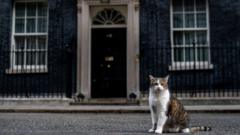Could Cats Be the Solution to Parliamentary Pest Problems?

A Labour Peer’s Proposal for Cats in Parliament: A Paws and Effect Debate
The recent debate surrounding the introduction of cats to control vermin in the Houses of Parliament has sparked curiosity and amusement among the public. While the notion of furry felines roaming the historic halls of Westminster might seem charming, the practicalities of such an initiative have led to its rejection. Senior Deputy Speaker Lord Gardiner of Kimble outlined the challenges and risks involved, making it clear that the idea of using cats as pest control was not feasible in the current environment. This article delves into the implications of this proposal, explores the ongoing issue of vermin in Parliament, and considers alternative pest control measures.
The Context of the Proposal
In a written question posed by Labour peer Lord Berkeley, the potential role of cats in managing the pest problem across the Parliamentary Estate was raised. This question prompted an official response from Lord Gardiner, who highlighted several key reasons why integrating cats into the pest control strategy was not suitable. The backdrop of this discussion is significant; mice have long been a persistent issue within the Grade I listed building, with substantial funds allocated to pest control services each year.
Understanding the Pest Problem in Parliament
The ongoing problem with mice and other vermin in the Palace of Westminster is not just a minor inconvenience; it reflects a larger challenge faced by many historic buildings around the UK. These structures are often characterized by intricate architecture that can create numerous hiding spots for pests. Additionally, the combination of age, construction work, and the presence of food waste can exacerbate infestations.
- Historical Architecture: The design of historic buildings can encourage pest habitation.
- Construction Activities: Ongoing renovations can disrupt existing pest control measures.
- Food Waste Management: High foot traffic often leads to food scraps, attracting rodents.
Why Cats Were Considered
Cats have long been recognized for their natural hunting abilities and have been employed historically in various settings to control rodent populations. The idea of utilizing cats in Parliament was likely inspired by successful cases in other institutions and homes. Cats like Larry, who has served as the chief mouser at 10 Downing Street since 2011, have become emblematic of a charming yet practical approach to pest management.
The Role of Larry the Cat
Since his arrival in Downing Street, Larry has become a beloved figure, serving successive prime ministers and charm offensive at the heart of British politics. His presence underlines the cultural significance of pets in both domestic and political spheres. However, it is crucial to note that the environment of 10 Downing Street differs significantly from that of the Palace of Westminster, where safety and care for cats would pose serious challenges.
The Risks Highlighted by Lord Gardiner
Lord Gardiner outlined several important risks associated with introducing cats to the Parliamentary Estate:
- Construction Activity: The current state of ongoing renovations presents safety hazards for any free-roaming cats.
- Self-Closing Doors: The risk of cats getting trapped in areas without easy access to food or care is a genuine concern.
- Lack of Care Arrangements: There are no guaranteed systems in place for the daily care and well-being of any introduced cats.
These considerations illustrate the complexity of introducing pets into a busy working environment, especially one as dynamic as Parliament. The safety and welfare of any animal should be paramount, and the risks outlined by Lord Gardiner offer a pragmatic perspective on the proposal.
Current Pest Control Measures
In light of the rejection of the cat proposal, the Palace of Westminster continues to rely on its pest control contractor to manage the ongoing vermin issue. This approach typically involves a combination of preventive measures and targeted interventions, including:
- Regular Inspections: Routine checks ensure that any signs of infestation are addressed promptly.
- Exclusion Techniques: Sealing entry points and ensuring food waste is managed effectively are critical steps.
- Humane Trapping: When necessary, humane traps are employed to capture and relocate pests rather than exterminating them.
Financial Implications of Pest Control
Managing pests in the Palace of Westminster is not without cost. Taxpayer money is often utilized to fund these pest control efforts, leading to discussions around efficiency and effectiveness. The question of how much is spent on pest control each year can raise eyebrows, especially in the context of public service budgets and priorities.
Alternative Pest Control Solutions
In light of the challenges associated with using cats for pest control, exploring alternative solutions becomes vital. Some effective measures that have been employed in other contexts include:
- Ecological Approaches: Introducing natural predators in a controlled manner can help manage pest populations sustainably.
- Technological Solutions: Utilization of electronic pest control devices can reduce reliance on traditional methods.
- Community Involvement: Engaging staff and the public in proper waste disposal practices can significantly decrease food sources for vermin.
Lessons from Other Institutions
Several institutions and organizations have successfully managed pest problems through innovative strategies. For example, the Foreign Office had its own chief mouser, Palmerston, who served his role effectively until retirement. The adaptability and creativity in addressing pest challenges can serve as inspiration for Parliament and other similar institutions.
Conclusion: The Future of Pest Control in Parliament
The rejection of the proposal to introduce cats into the Palace of Westminster highlights the complexities of managing pest control in a historic and active governmental space. While the idea of having cats roam the halls may be appealing, the practical considerations regarding their safety and care cannot be overlooked. Instead, a continued focus on effective pest management strategies that prioritize humane treatment and ecological sustainability is necessary.
As Parliament navigates its pest control challenges, the dialogue surrounding innovative solutions remains vital. The ongoing commitment to effective pest management reflects a serious approach to the maintenance of one of the UK's most iconic buildings. With the right strategies in place, Parliament can ensure a balance between preserving its historical integrity and maintaining a healthy environment for all who work within its walls.
FAQs
What are the main challenges of introducing cats to Parliament?
The main challenges include construction risks, the potential for cats to become trapped due to self-closing doors, and the lack of assured daily care for the animals.
How much is spent on pest control in Parliament each year?
While specific figures can fluctuate, significant funds are allocated annually to pest control measures within the Palace of Westminster, reflecting the ongoing nature of the vermin issue.
What alternative pest control methods are effective?
Effective methods include ecological approaches, technological solutions like electronic pest devices, and community involvement in proper waste disposal practices to reduce food sources for pests.
As we reflect on the implications of this debate, it is worth considering: How can we balance the charm of animal companionship with the practicalities of maintaining a historic government space? #PestControl #Parliament #CatsInPolitics
Published: 2025-06-18 16:42:10 | Category: sport



